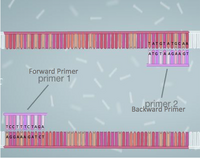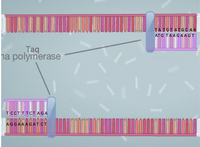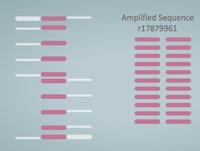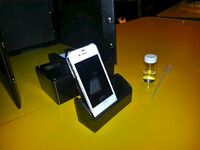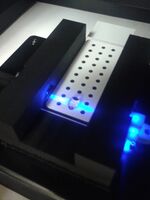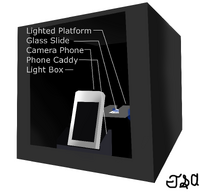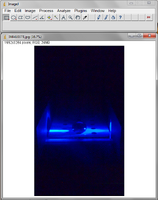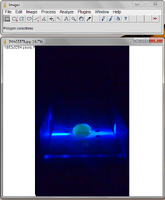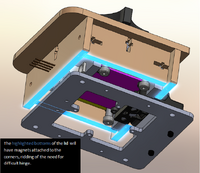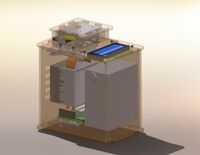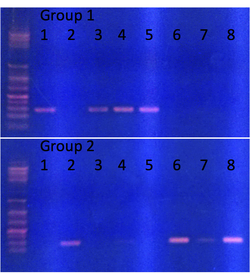BME103
| Home People Lab Write-Up 1 Lab Write-Up 2 Lab Write-Up 3 Course Logistics For Instructors Photos Wiki Editing Help | |
|
Introduction to Biomedical Engineering DNA Lab Learning Objectives: Students should leave this unit equipped with a theoretical understanding of how to detect DNA biomarkers and the relevance of this technology to human healthcare. Emphasis will be on good lab/experimental controls and the collection of statistically valid measurements. Students will also understand how commonly used lab devices function, and explore the recent efforts to simplify experiments and to lower costs. At the end of the section, students will explore creative new biosensor designs based on PCR and fluorescent imaging.
GETTING STARTED
THE DNA LABS IN REVIEWSet-up: OpenPCR BuildingBefore this unit began, a group of ~10 upper level undergrads and graduate students assembled the OpenPCR machines. This was a great experience for the graduate students, and saved our Freshmen engineers the time and trouble of assembling the delicate pieces from scratch in a very limited amount of time. Thanks to our assembly team and Dr. Pizziconi's Design Studio team for your help!
Week 1: Introduction - DNA as a Biomarker, 10/17/12Students were introduced to basic DNA science and its relationship to diagnostics and health. Sequence-specific DNA hybridization uses primers designed to base-pair with a target disease-associated marker. This leads to exponential amplification of an invisible DNA target. A mismatch (non-disease DNA sequence) does not produce amplification. Team members chose roles as Open PCR machine tester/ engineer, Experimental protocol planner, and Research and development scientist.
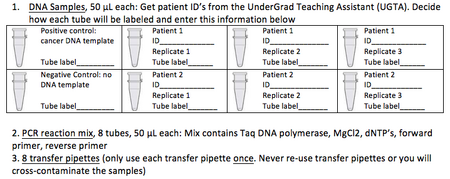 In concurrent work sessions...
Week 2: DNA Amplification Reactions, 10/24/12Students used their experience from the previous week to set up and run a PCR experiment. The students were provided with personal protective equipment, 8 tubes of 50 μL PCR reaction mix, 8 tubes of 50 μL diluted template + primers, and disposable transfer pipettes. The instructors provided positive and negative "patient" samples so that some samples would test positive for a DNA marker (produce amplification), and others would test negative (no amplification). Experimental protocol planners set up and ran the PCR reactions. These were set aside to run for ~2 hours.
Week 3: Computer-Aided Design with SolidWorks, 10/31/12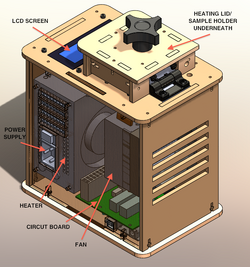 Students were instructed on navigating the NCBI dsSNP database to find disease-associated SNP's and disease prediction information. Students were also introduced to Wiki web page editing. Concurrent work sessions:
Week 4: Measuring DNA Using Fluorescence, 11/7/12Samples were mixed with SYBR green dye and analyzed on Single Drop Fluorimeters. Students used 2 μg/mL purified calf thymus DNA to calibrate the DNA measurement process. Using this value, they were able to convert the PCR results from brightness into DNA concentration. Summaries of their results are available on the Lab Report 1 page.
Lab Report 1: Each team created a Wiki page write-up of their learning experiences. Week 5: Designing a New System, 11/14/12The class discussed some of the strengths and areas for possible improvement of the DNA amplification and detection system. Each team then conceptualized a new DNA detection system based on OpenPCR and the Single Drop Fluorimeter. Concurrent work sessions:
Week 6 & 7: Advertisement Videos, 11/28/12 & 12/6/12The instructors presented PCR and DNA detection systems that are currently on the market. The systems included super-compact personal PCR machines to very large systems that were capable of both amplifying and measuring the levels of DNA in real time. Lab Report 3: Each team created an advertisement video for their new system. These videos were showcased in class. How Well Did OpenPCR + Single Drop Imaging Perform?The instructors compared traditional gel electrophoresis with the results from the new single drop Fluorimeter approach. Each Sample either has template DNA or is blank. Only DNA Samples should produce amplification (visible band as a Gel result, or high Fluorimeter value). The OpenPCR system successfully amplified products of the expected size, and the Single Drop Fluorimeter measurements agreed with gel electrophoresis data. Overall, the system is a success.
| |
